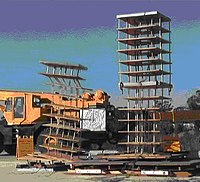
Photo from wikipedia
Masonry structures are often characterized by complex, non-planar geometries. This is also the case for historical and monumental structures. Here we investigate the dynamic behaviour of non-standard, curvilinear masonry geometries,… Click to show full abstract
Masonry structures are often characterized by complex, non-planar geometries. This is also the case for historical and monumental structures. Here we investigate the dynamic behaviour of non-standard, curvilinear masonry geometries, such as vaults, subjected to blast loading. We use the Discrete Element Method (DEM) for modelling the dynamic structural response to explosions. The approach allows considering the detailed mechanical and geometrical characteristics of masonry, as well as the inherent coupling between the in- and out-of-plane motion. The proposed modelling approach is validated with existing experimental tests in the case of planar masonry geometries, walls. The DEM model well captures the dynamic response of the system and the form of failure within the masonry structure. Then the response of a curved masonry structure subjected to blast loading is investigated. The influence of various micro-mechanical parameters, such as the dilatancy angle, the tensile strength and the cohesion of the masonry joints on the overall dynamic structural response of the system is explored. The effect of the size of the building blocks is also studied. Finally, the common DEM assumption of rigid blocks is assessed through detailed comparisons with simulations involving deformable blocks.
Journal Title: Engineering Structures
Year Published: 2020
Link to full text (if available)
Share on Social Media: Sign Up to like & get
recommendations!